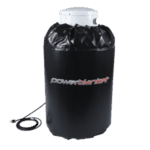When using gas containers, it’s important to know how gas pressure impacts flow. There are a number of ways you can determine the best methods to increase gas flow rate.
How To Increase Gas Pressure and Flow
Pressure of the gas in a container is created by the number of collisions the molecules have with each other and with the surface of the container. Increasing the number of collisions will increase gas flow rate.
Molecular Collisions

Temperature control is the most important factor in increasing gas flow rate, due to its influence on the movement of molecules that make up the gas. According to kinetic molecular theory, “the average kinetic energy of a collection of gas particles depends on the temperature of the gas and nothing else.”
There are a few ways to increase the number of collisions.
- Alter the chemistry of the gas by adding more molecules by filling the tank: more molecules in the same size container will increase the number of times molecules collide.
- Increase the temperature: increasing the temperature will increase the speed at which the molecules move and therefore increase the number of collisions that take place in the container.
- Decrease the size of the container: this forces the molecules into a smaller area, increasing the number of collisions that take place.
As simple as these three options sound, not all of them are viable. The first step to determine which option is right for your gas containers (and increase your gas flow rate) is to evaluate your gas pressure and flow needs.
Assessing the Situation
Let’s assume that you already have the tank you want to use, and you are not interested in making any changes to the container or system. Option 3 is out because it deals with changing the size of the container. Let’s also say, to your knowledge, the tank is full and there are no more molecules to add, eliminating option 1 as a viable solution. That brings us to option 2: temperature increase.
When the temperature is lower, it is very difficult to maintain an optimal gas flow rate. Lower temperatures=fewer collisions in the tank. This prevents the gas from vaporizing, rendering it virtually useless. Propane, butane, nitrogen, oxygen and other compressed gasses need temperature control to ensure optimal gas flow rates. Bringing the container/system up to a temperature above the cooler existing ambient temperature will result in increased pressure, flow and efficiency.
Use Heating Blankets to Increase Gas Flow Rate
Heating blankets are an excellent solution to increase temperatures for improved flow rates. These blankets wrap around or lay over a variety of products and equipment to provide heat. If installed properly, these apply 
Powerblanket offers a variety of gas cylinder heating blankets through its propane tank heaters line of products for controlling temperatures of compressed gasses. These heating blankets provide uniform heat for controlling temperatures of compressed gasses and a uniform barrier of heat across the entire cylinder, as well as other parts of the gas delivery system. This superior heating solution reduces cost by optimizing container temperatures and increasing gas flow rates.
Case Study: Hydrocarbon Gas
A large semiconductor manufacturing company needed a new product to improve their semiconductor manufacturing process. They needed to maintain the flow of their gas delivery system more precisely, and their existing solution did not offer the consistency they desired.
Powerblanket designed a heating product for their gas delivery system that maintained the precise temperature and increase gas flow rate for hydrocarbon gases.
The company’s management team later admitted that they were initially against the idea of switching to the Powerblanket specialty gas heating solution. A spokesperson for the company said said they were surprised that the solution was so simple:
“We didn’t think it would work because it was half the power of the status quo product, but after we gave it a try, we were immediately sold. It’s a fantastic product and the sales and engineering support we received was excellent.”
Case Study: Propane
Shannon Stillman, a Pyro Engineer at Thor Productions, explained how Powerblanket improved their gas flow:
“We use propane in large volumes – over ½ ton each night per event. Each of our cylinders are wrapped with a Powerblanket Gas Cylinder Heater, extending the allowable duration by at least 60%. This equates to hundreds of usable pounds of propane per night. In addition, the UL listing and safety ratings of the Powerblanket products resolve the concerns of the site safety managers, AHJs (Authorities Having Jurisdiction) and Fire Marshals.”
The Powerblanket Advantage
Powerblanket has the most efficient gas tank heaters on the market. Our heating blankets will overcome the effects of cold weather and maintain pressure and efficiency on any gas container. Add a Beacon control unit to your system, and you can monitor your tank heater remotely and gather important temperature data. Whether you need an off-the-shelf heating blanket or a custom, tailor-made tank heater, Powerblanket has got you covered by assuring you with the following benefits:
- Increase gas flow rate and efficiency of gas tanks
- Save money by optimizing gas and material usage
- Eliminate unnecessary cylinder refills in cold weather
- Insulated full-wrap design
Powerblanket tank heaters are the best of the best. Use Powerblanket’s propane tank heaters to increase gas flow rates and extend the amount of gas you have on hand. For more information, call 866.945.4203 or email [email protected].
Keep your propane tanks at the perfect pressure with Powerblanket.








